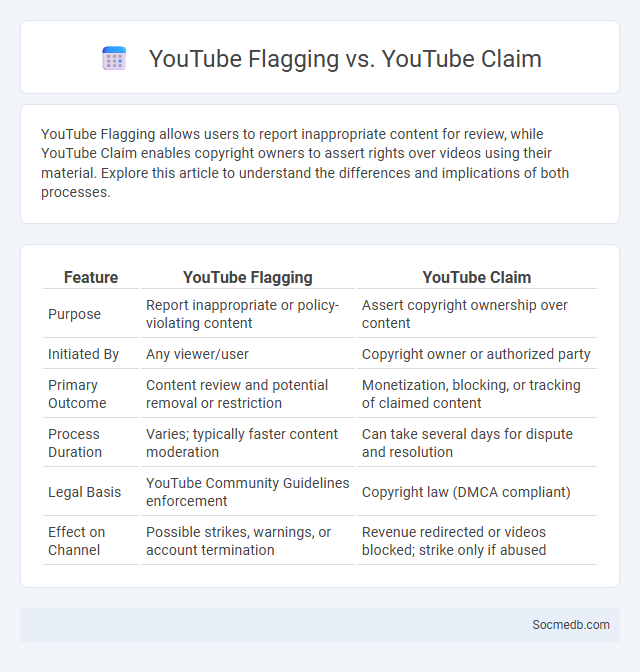
Photo illustration: YouTube Flagging vs YouTube Claim
YouTube Flagging allows users to report inappropriate content for review, while YouTube Claim enables copyright owners to assert rights over videos using their material. Explore this article to understand the differences and implications of both processes.
Table of Comparison
| Feature | YouTube Flagging | YouTube Claim |
|---|---|---|
| Purpose | Report inappropriate or policy-violating content | Assert copyright ownership over content |
| Initiated By | Any viewer/user | Copyright owner or authorized party |
| Primary Outcome | Content review and potential removal or restriction | Monetization, blocking, or tracking of claimed content |
| Process Duration | Varies; typically faster content moderation | Can take several days for dispute and resolution |
| Legal Basis | YouTube Community Guidelines enforcement | Copyright law (DMCA compliant) |
| Effect on Channel | Possible strikes, warnings, or account termination | Revenue redirected or videos blocked; strike only if abused |
Understanding YouTube Flagging: What Does It Mean?
YouTube flagging occurs when users report content that may violate community guidelines, such as inappropriate material, spam, or copyright infringement. Understanding this process helps you ensure your videos comply with YouTube's policies to avoid removal or penalties. Timely review and addressing flagged content protects your channel's reputation and maintains audience trust.
The Basics of YouTube Content Claims
YouTube content claims occur when a copyright owner identifies materials in your video that match their protected content, often resulting in monetization changes or video restrictions. Understanding the Content ID system helps you navigate claims, ensuring your rights are respected while avoiding penalties or removals. Your ability to manage these claims effectively safeguards your channel's reputation and revenue stream on the platform.
YouTube Flagging vs. Claiming: Key Differences
YouTube flagging involves reporting videos that violate community guidelines, prompting review and potential removal by the platform, while claiming refers to copyright owners identifying content using their assets to monetize, block, or track views. Your understanding of these processes is crucial for managing content rights and maintaining compliance with YouTube's policies. Effective use of flagging protects the community from harmful content, whereas claiming safeguards intellectual property and revenue streams.
Community Guidelines: How Flagging Works on YouTube
YouTube's Community Guidelines flagging system enables users to report content that violates platform policies, such as hate speech, harassment, or misinformation. When you flag a video, YouTube's automated algorithms and human moderators review the report to determine if the content should be removed or age-restricted. This process helps maintain a safe and respectful environment for your viewing experience and the broader community.
Copyright System Explained: The YouTube Claim Process
The YouTube copyright claim process is designed to protect your original content from unauthorized use by others. When a copyright owner detects infringement, they can submit a Content ID claim or a manual takedown request to YouTube, triggering automatic actions such as video monetization, blocking, or removal. Understanding this system ensures you maintain control over your intellectual property while complying with YouTube's policies to avoid penalties.
Consequences of Flagging vs. Claiming Content
Flagging content on social media triggers platform review processes that can lead to content removal or account suspension based on community guideline violations, influencing user behavior and platform integrity. Claiming content, especially in cases like copyright, often involves formal legal processes that may result in content takedowns or revenue sharing claims, directly impacting creators' earnings and intellectual property rights. Both mechanisms enforce accountability but differ in scope, with flagging emphasizing policy compliance and claiming prioritizing legal ownership.
Who Can Flag or Claim Videos on YouTube?
YouTube allows users, copyright owners, and content creators to flag or claim videos that violate community guidelines or copyright policies. Copyright owners can submit claims through YouTube's Content ID system to monetize, block, or track unauthorized use of their work. Your ability to flag a video helps maintain platform safety by reporting inappropriate content for review by YouTube's moderation team.
How to Respond to a YouTube Flag or Claim
Responding to a YouTube flag or claim requires promptly reviewing the notification details in Your YouTube Studio dashboard to understand the nature of the issue, whether it involves copyright, community guidelines, or monetization. Gather relevant evidence, such as original content proofs or licenses, to submit a formal dispute or appeal through YouTube's official channels. Maintaining clear documentation and adhering to YouTube's policies enhances the chances of a successful claim resolution and protects Your channel's reputation.
Preventing Unnecessary Flags and Claims on Your Channel
Ensuring your content complies with platform guidelines reduces the risk of unnecessary flags and claims on your social media channel. Use clear, original media and properly credit any third-party materials to avoid copyright disputes. Monitoring your posts regularly helps maintain your channel's reputation and prevents disruptions from false accusations.
Frequently Asked Questions: Flagging vs. Claiming on YouTube
Flagging on YouTube allows users to report inappropriate content that violates community guidelines, while claiming involves copyright holders asserting ownership over videos using YouTube's Content ID system. You should flag videos that contain harmful or offensive material, whereas claiming is appropriate when protecting your copyrighted content from unauthorized use. Understanding the difference helps ensure your reports or claims are handled correctly and effectively.
 socmedb.com
socmedb.com